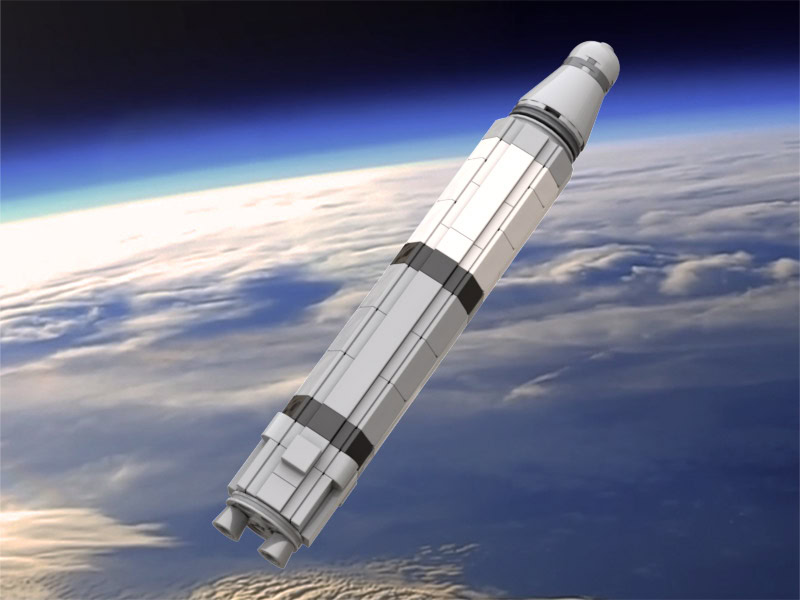
LEGO Designer:
Dan Fallon (phreaddee)
Nicolas Riveau (LegoRocketCollection)
Designed:
June 2021
Categories:
All, Launch Vehicles, Small Lift Launch Vehicles
Launch Vehicle Details
Stages:
Length:
Diameter:
Mass at Launch:
Low Earth Orbit Capacity:
Total Thrust:
Apogee:
Class:
Blue Streak was a British Rocket originally developed as an ICBM. The project was intended to maintain an independent British nuclear deterrent, replacing the V bomber fleet which would become obsolete by 1965. The operational requirement for the missile was issued in 1955 and the design was complete by 1957. During development, it became clear that the missile system was too expensive and too vulnerable to a surprise attack. The missile project was cancelled in 1960, with US-led Skybolt the preferred replacement.
Partly to avoid political embarrassment from the cancellation, the UK government proposed that the rocket be used as the first stage of a civilian satellite launcher called Black Prince. As the cost was thought to be too great for the UK alone, international collaboration was sought. This led to the formation of the European Launcher Development Organisation (ELDO), with Blue Streak used as the first stage of a carrier rocket named Europa.
In November 1961 at a Nine-nation Western European Conference in London, it was announced of the decision to launch a satellite in mid-1965, using a British Blue Streak first stage, a French Veronique second stage, and a West German Astris third stage, from the Woomera range in Australia, and it was to be developed with the aim of delivering space access technology, and more specifically to facilitate the deployment of European-wide telecommunication and meteorological satellites into orbit.
After successfully passing her static tests, Blue Streak was shipped off to Australia, To be launched from Woomera LA-6, at Lake Hart, with its maiden launch (F1) on 4 June 1964 a success reaching a height of 157km (97miles).
The Blue Streak rocket successfully launched a further 2 times on 19 October 1964 (F2) and 23 March 1965 (F3).
For its fourth launch (F4) on 23 May 1965 Blue Streak was launched with Dummy second and third stages, and dubbed ELDO A. Upon reaching a height of 86km (53miles) the flight was terminated. A further successful launch with dummy upper stages happened on 15 November 1966 (F5).
However further launches with a live second stage (Now referred to as Europa I proved unsuccessful with two 2nd stage failures, 4 August 1967 (F6.1) and 4 December 1967 (F6.2). Despite this an attempt was made on 29 November 1968 (F7), to launch a complete 3 stage vehicle and launch a satellite into orbit, and whilst the 2nd stage was successful in firing the third stage exploded. Britain withdrew from ELDO later in 1968 to focus on their Black Arrow rocket. There was another Europa I launch attempt on 3 July 1969 (F8) however it was another unsuccessful 3rd stage.
The final Europa I launch from Woomera happened on 12 June 1970 (F9) – where all three stages were successful, but the fairing failed to separate on the payload and thus the satellite was unable to reach orbit.
After ten test launches, it was decided that the Woomera launch site was not suitable for putting satellites into geosynchronous orbit, and it was decided to move the project to the French site of Kourou in South America. Blue Streak was used for the Europa II’s (F11) one and only launch on 5 November 1971 – which due to guidance signals being reversed resulted in yet another failure.
The launch of F12 was postponed whilst a project review was carried out, which led to the decision to abandon the Europa project altogether.
Following the British withdrawal from ELDO in 1968 it was decided that the Blue Streak rocket was to be replaced with the french designed Diamant. It was planned the Blue Streak’s involvement with the project would last until 1973, but as the project was abandoned the Diamant was never used although it went on to be relatively successful in its own right, and the technology used become the predecessor for the Ariane Launch Vehicles.
In 1972 ELDO was disbanded and later merged with the European Space Research Organisation to form the European Space Agency (ESA) in 1975.
Part count: bricks, lots.
| Unit | width | length | height |
|---|---|---|---|
| Studs | |||
| Inches | |||
| Centimetres |
No external URL provided.
Launch History information from space.skyrocket.de
Launch History information from space.skyrocket.de
Related Posts
None found